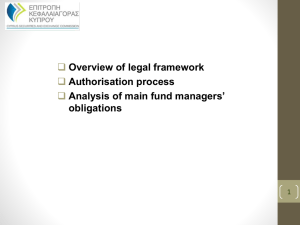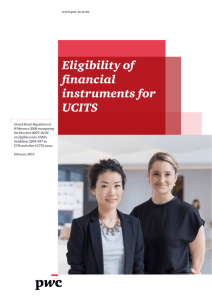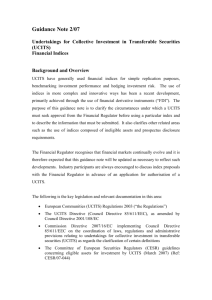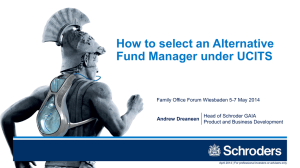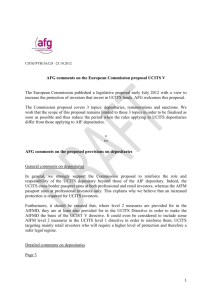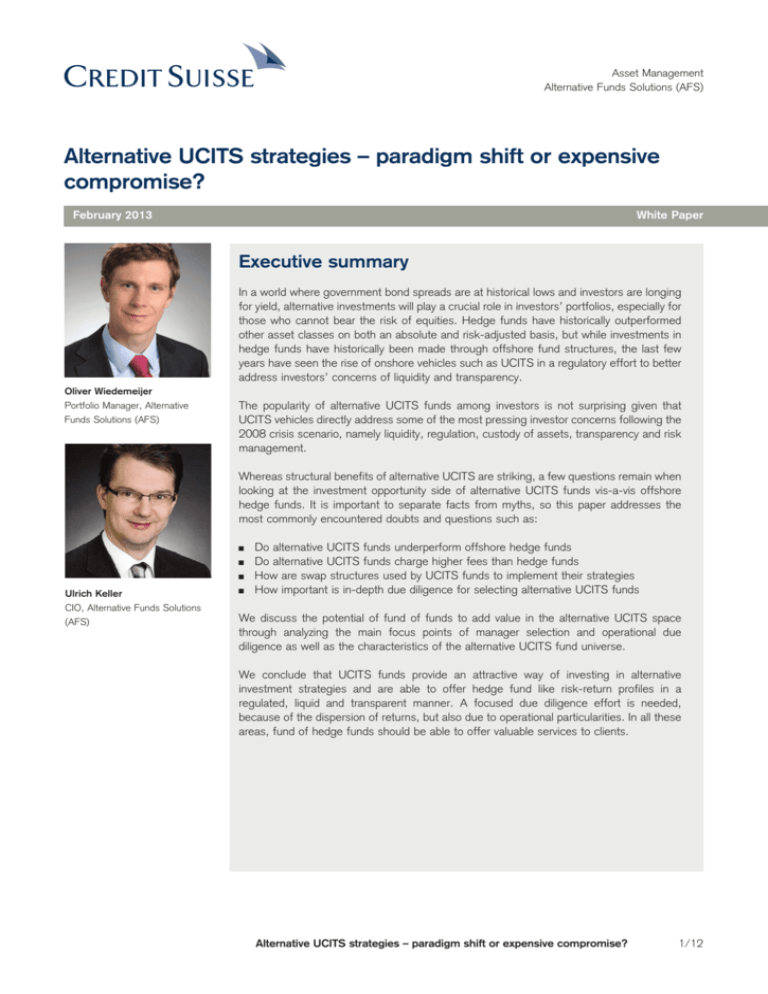
Asset Management
Alternative Funds Solutions (AFS)
Alternative UCITS strategies – paradigm shift or expensive
compromise?
February 2013
White Paper
Executive summary
In a world where government bond spreads are at historical lows and investors are longing
for yield, alternative investments will play a crucial role in investors’ portfolios, especially for
those who cannot bear the risk of equities. Hedge funds have historically outperformed
other asset classes on both an absolute and risk-adjusted basis, but while investments in
hedge funds have historically been made through offshore fund structures, the last few
years have seen the rise of onshore vehicles such as UCITS in a regulatory effort to better
address investors’ concerns of liquidity and transparency.
Oliver Wiedemeijer
Portfolio Manager, Alternative
Funds Solutions (AFS)
The popularity of alternative UCITS funds among investors is not surprising given that
UCITS vehicles directly address some of the most pressing investor concerns following the
2008 crisis scenario, namely liquidity, regulation, custody of assets, transparency and risk
management.
Whereas structural benefits of alternative UCITS are striking, a few questions remain when
looking at the investment opportunity side of alternative UCITS funds vis-a-vis offshore
hedge funds. It is important to separate facts from myths, so this paper addresses the
most commonly encountered doubts and questions such as:
Ulrich Keller
CIO, Alternative Funds Solutions
(AFS)
Do alternative UCITS funds underperform offshore hedge funds
Do alternative UCITS funds charge higher fees than hedge funds
How are swap structures used by UCITS funds to implement their strategies
How important is in-depth due diligence for selecting alternative UCITS funds
We discuss the potential of fund of funds to add value in the alternative UCITS space
through analyzing the main focus points of manager selection and operational due
diligence as well as the characteristics of the alternative UCITS fund universe.
We conclude that UCITS funds provide an attractive way of investing in alternative
investment strategies and are able to offer hedge fund like risk-return profiles in a
regulated, liquid and transparent manner. A focused due diligence effort is needed,
because of the dispersion of returns, but also due to operational particularities. In all these
areas, fund of hedge funds should be able to offer valuable services to clients.
Alternative UCITS strategies – paradigm shift or expensive compromise?
1/12
The search for yield – something’s gotta give
In a world where government bond spreads are at historical lows and investors are
longing for yield, alternative investments will play a crucial role in investors’ portfolios,
especially for those who cannot bear the risk of equities. As many investors continue
to worry about their bond allocations, which have enjoyed an extended rally on the
back of Central Bank intervention over the last quarters and years, they turn to actively
managed investment strategies such as the ones offered by hedge funds to provide
them with attractive returns.
Exhibit 1* – Government 10 year bond yields
6.0
5.5
5.0
4.5
4.0
3.5
%
3.0
2.5
2.0
1.5
1.0
Jan 07
Jan 08
USD Bond 10Y
CHF Bond 10Y
Jan 09
Jan 10
Jan 11
Jan 12
EUR Bond (Germany) 10Y
JPY Bond 10Y
Jan 13
GBP Bond 10Y
Sources: Credit Suisse, Bloomberg
Hedge funds have historically outperformed other asset classes on both an absolute and riskadjusted basis. Since the beginning of 2000 hedge funds have returned +120% (DJ CS Hedge
Fund Index) versus equity markets’ +27% (MSCI World Index) with hedge funds exhibiting
roughly half the volatility and half the maximum drawdown of equities*. Similar results can be
observed for longer time periods.
Exhibit 2* – Hedge fund index performance vs. other asset classes
500
CAGR* Risk**
450
400
8.6%
7.5%
350
300
16%
6.3%
250
5.6%
6.1%
200
150
0.7%
3.6%
100
* compound annual
50
growth rate
0
** annualized volatility
Dec 93 Dec 95 Dec 97 Dec 99 Dec 01 Dec 03 Dec 05 Dec 07 Dec 09 Dec 11
MSCI World Equity Index
Barclays Global Aggregate Bond Index
JPM US 1 Month Cash Total Return Index
Dow Jones Credit Suisse Hedge Funds Index
Sources: Credit Suisse, Bloomberg
Such risk-return characteristics are attractive and have resulted in inflows to the industry over the
past years, especially from institutional investors, which appreciate the diversification benefits
hedge funds can provide to their portfolios. Consequently, hedge funds are in high demand.
According to HFR, hedge fund industry assets under management have surpassed pre-crisis
levels and reached a record high of USD 2.25trn as of the end of 2012.
* Historical performance indications and financial market scenarios are no guarantee for current or future performance.
Alternative UCITS strategies – paradigm shift or expensive compromise?
2/12
Alternative UCITS – the new poster child of the hedge fund industry
While investments in hedge funds have historically been made through offshore fund structures,
the last few years have seen the rise of onshore vehicles in a regulatory effort across the globe to
better address investors’ concerns of liquidity and transparency. In Europe, the UCITS Directive
has evolved into one of the most widely recognized regulatory frameworks of investment funds
allowing investors to access hedge fund strategies through UCITS compliant onshore structures
whilst obtaining increased transparency and liquidity. According to Eurekahedge, the alternative
UCITS fund universe currently has over USD 200bn in AUM, which has been growing steadily and
fast through the last couple of years.
Exhibit 3 – Development of UCITS industry
250
1000
900
200
800
700
150
600
500
400
100
300
200
50
100
0
0
Dec 07
Jun 08
Dec 08 Jun 09
Number of funds (LHS)
Dec 09 Jun 10
Dec 10
Jun 11
Dec 11
Feb 12
AuM (US$ billion, RHS)
Source: Eurekahedge
While current yields are at historically low levels, equities exhibit high volatility and passive
investment strategies can struggle in range-bound markets, alternative strategies are much less
restricted and can profit from ample opportunities in such markets and from decreasing
competition from investment banks. Consequently, alternative UCITS funds are increasingly used
by investors to mitigate losses during market stress periods and to improve the risk-return
characteristics of their portfolios. However, while many investors have flocked to these new
structures, alternative UCITS funds do have their adversaries, too. Since this branch of the hedge
fund industry is still relatively new, it remains surrounded by myths and doubts, especially with
regards to the investment strategies and explicit and implicit costs. Therefore, it is worthwhile to
examine the alternative UCITS universe and to try answering those pressing questions, since the
alternative UCITS universe is growing fast, it addresses investor concerns, and more and more
hedge fund managers turn to the UCITS framework to launch their regulated fund vehicles
increasing the variety of available funds.
Strategy with tailwind
UCITS stands for Undertakings for Collective Investment in Transferable Securities and has been
developed over the last couple of decades in order to enhance investor protection within the
investment fund markets. The main focus of the directive was on providing a clear definition of
allowed instruments, level of liquidity, diversification and transparency. When the framework first
came to fruition in 1985, the main target were traditional funds, which meant that derivatives, for
example, could only be used in a limited way i.e. for efficient portfolio management purposes. As
global markets evolved and products became more complex, the UCITS directive has been
enhanced steadily. The latest set of rules, UCITS IV, which came into effect in 2011, has a much
broader investment scope allowing a wider range of instruments and also knows much less
restrictions regarding the use of derivatives. This has opened the UCITS framework for the creation
of new funds that follow less restricted strategies, so-called alternative UCITS strategies, which are
the focus of this paper and allow the implementation of hedge fund strategies.
Alternative UCITS strategies – paradigm shift or expensive compromise?
3/12
The regulatory and political focus in Europe and the steady implementation of the various UCITS
directives have built a strong reputation, which has turned UCITS into a globally recognized brand
of regulated investment funds. As a result, more and more hedge funds have launched onshore
vehicles that are UCITS compliant. The overall UCITS industry is huge with over 36’000 funds
and USD 6trillion in assets across traditional and alternative funds1. While still somewhat new to
the UCITS framework, alternative UCITS funds have established themselves within the alternative
asset management world. Alternative UCITS assets have multiplied between 2008 and 2012 and
reached over USD 200billion, as more and more investors have been seeking to put money in
alternative investment regulated onshore vehicles. Alternative UCITS posted back to back
strategy inflows in the last years even as offshore hedge fund AUMs have stagnated. Additionally,
renowned hedge fund firms such as Brevan Howard, Winton or AQR have successfully launched
alternative UCITS investment vehicles offering their strategies in a UCITS compliant vehicle,
which has broadened the investment universe and given additional confidence to investors.
Alternative UCITS – Thinking inside the box
The popularity of alternative UCITS funds among investors is not surprising given that UCITS
vehicles directly address some of the most pressing investor concerns following the 2008 crisis
scenario, namely liquidity, regulation, custody of assets, transparency and risk management.
Exhibit 4 – Investor concerns addressed
Following the events of 2008 and 2009, UCITS compliant funds have been increasingly favored by
investors as they address liquidity, transparency, risk management and asset
Investor concern
UCITS IV answer
Liquidity
Weekly liquidity
Fraud
Strong regulatory oversight
Risk management
Processes signed off by the regulator
Transparency
Reporting standards
Diversification
Portfolio concentration limits
Regulatory oversight
Fraud cases such as “Madoff” have resulted in investors turning away from offshore hedge funds
to alternative UCITS funds and other regulated vehicles. However, even without such cases it is
easy to see the benefits for investors, as with UCITS funds they do not have to ship their assets
offshore to jurisdictions such as the Cayman Islands and get to enjoy tax transparency in multiple
countries across Europe. In addition, current efforts by governments and regulators to work on new
capital market regulations such as the AIFMD, have further increased uncertainty among investors
and further interest in UCITS compliant vehicles, as UCITS funds explicitly lie outside of the AIFMD
scope and already possess a European passport allowing distribution across Europe.
A UCITS fund needs to be approved by the local regulator at launch. As an example, the CSSF
(Commission de Surveillance du Secteur Financier) is responsible for approvals in Luxembourg.
When a UCITS fund is structured as a SICAV (Societe d’Investissement a Capital Variable), there
will also be a board of directors, which has additional oversight over the fund.
Arguably one of the most effective measures taken by the UCITS directive to provide investor
protection is the requirement for UCITS funds to hire independent service providers such as
trustees, auditors, administrator and custodian. As for fraudulent activities, it can be said that while
it is impossible to guarantee total protection from fraud risk, the independent custody of assets
should significantly improve the protection of investors’ assets.
1
Source PWC UCITS Fund Distribution 2012
Alternative UCITS strategies – paradigm shift or expensive compromise?
4/12
Liquidity
Compared to offshore hedge funds, which typically have monthly or quarterly redemption frequencies
and can lock up investors for a certain amount of time, UCITS funds have to offer redemptions at
least twice a month. In fact, more than three quarters of alternative UCITS funds offer daily liquidity,
with the remainder offering weekly liquidity (less than 1% of funds offer bi-weekly liquidity)2. The
UCITS framework also defines eligible and non-eligible assets as well as diversification standards (for
example, real estate or private equity investments are not eligible and the maximum position size is
10%), which again helps underlying liquidity of the investments in general.
Transparency
Transparency is one of the main tools of the UCITS regulations to achieve greater investor
protection. There are clear guidelines for reporting and representing a fund’s performance, risks and
objectives, as well as its investment process. Recently, the new UCITS IV directive has implemented
a new Key Investor Information Document, which has to disclose risks and investment objectives in
clear language to further increase transparency for investors.
Risk management
As already mentioned, within the UCITS directive there are clear rules for liquidity and
diversification as well as restrictions on instruments and leverage that can be applied by the
funds. Furthermore, regular reporting processes to both the regulator as well as the investor are
defined. Similarly, UCITS funds have to obey specific requirements for risk management, risk
reporting and counterparty exposure.
The advantages for investors are clear, but for hedge fund managers launching an alternative
UCITS vehicle, there are also benefits. First and foremost, they are able to diversify their investor
base regionally and across market segments. This effect is not limited to Europe but also includes
clients in Latin America and some Asian countries, where the UCITS brand is well recognized.
Also, since offshore hedge funds face uncertainties with regards to the Alternative Investment
Fund Managers directive (AIFMD), UCITS funds are explicitly out of scope of the directives and
possess a European passport.
Why you should not invest in alternative UCITS funds?
Whereas structural benefits of alternative UCITS are striking, a few questions remain when looking
at the investment opportunity side of alternative UCITS funds vis-à-vis offshore hedge funds. It is
important to separate facts from myths, so we will try to address the most commonly encountered
doubts and questions in the following paragraphs.
Claim: Alternative UCITS funds charge higher fees compared to offshore hedge
funds
Given the regulatory burden and other rules, such as regular reporting requirements, risk
management calculations, collateralization of swaps, fees charged by investment banking provided
platforms and others, it seems intuitive to assume that alternative UCITS funds have to shoulder
higher average fees. Furthermore, the operational requirements for a fund can be high and result in
additional costs to fund managers. However, managers are well aware of investors’ sensitivities of
fees and many strive to align costs of their alternative UCITS fund with their offshore fund. This is
mostly achieved by the manager deliberately forgoing some management fees or placing a ceiling for
overall costs. In fact, for the funds, in which Credit Suisse AFS is invested, the Total Expense Ratio
(TER) for alternative UCITS funds is slightly lower compared to the average TER for offshore hedge
funds. Therefore, overall it seems that fee differences between offshore and alternative UCITS funds
are minimal.
Claim: Alternative UCITS funds underperform offshore hedge funds
Many critics bring forward the argument that the flexibility that hedge funds enjoy is fundamentally at
odds with the UCITS restrictions. In fact, UCITS rules regarding eligible instruments, leverage, liquidity
2
Source: Alixcapital.com
Alternative UCITS strategies – paradigm shift or expensive compromise?
5/12
and diversification can curtail some investment strategies and as a consequence, one would intuitively
expect average returns of alternative UCITS funds to be slightly lower compared to offshore hedge
funds. However, results of recent empirical work are less clear, since the alternative UCITS industry
is still relatively young and also because reliable data series are hard to obtain.3
First of all, it has to be said that in the last couple of years alternative UCITS funds have delivered
risk adjusted performance that were similar to offshore hedge funds. One study even suggests that
alternative UCITS indices have outperformed offshore hedge fund indices over the period from 2008
to 2010.4 Still it seems intuitive that managers that are less constrained should be able to extract
higher returns over time. According to some studies, this seems to be the case if managers have
certain hedge fund manager experience or skills.5 One of the most comprehensive studies in that
respect, done by Lyxor, also finds that alternative UCITS funds exhibit lower volatility compared to
offshore fund, a finding that is shared with the Tuchschmid, Wallerstein and Zanolin study.
In summary, it seems that alternative UCITS funds exhibit lower volatility on average than offshore
hedge funds but tend to provide similar risk-return characteristics. Also, whether offshore funds
outperform alternative UCITS funds seems to depend on the investment strategy. The first point
seems to be a result from the fact that the restrictions in terms of leverage, diversification rules and
certain investment instruments leads fund managers to take less risk in terms of gross exposure and
portfolio concentration. The second point becomes clearer if we look at a few examples.
There are hedge fund strategies that fit well into the UCITS framework such as Equity Long/Short,
which is typically a liquid strategy that works well with low leverage. As an example, Exhibit 5 shows
the performance of a fund manager’s alternative UCITS fund vs. the same manager’s offshore hedge
fund, which follows the same Equity Long/Short investment strategy. It can be observed that the
performance is similar for both funds and that it remains consistent over time.
Exhibit 5 – Performance of Equity Long/Short Fund
4%
140
3%
140
130
2%
110
1%
100
0%
90
-1%
80
-2%
70
-3%
Apr 10
Oct 10
ELS UCITS Fund
Apr 11
Oct 11
Apr 12
Oct 12
60
ELS Hedge Fund
Source: Credit Suisse/Data as of Jan 2013
Exhibit 6 shows a similar example for a fund manager, which follows an Event Driven hedge fund
strategy, which is managed through an alternative UCITS fund and an offshore hedge fund. It can be
seen that the performance of the two funds deviates over time and also that the difference is not very
consistent on average. This is a result of the offshore fund’s investment strategy, which entails
investing in certain bank loans, credit or slightly less liquid securities. Such investments are excluded
in the alternative UCITS fund. Consequently, the two funds show some performance differences,
which can be taken as an indication that in this case, the offshore hedge fund’s strategy cannot be
well implemented in the alternative UCITS framework.
3
4
5
E.g. see studies of Tuchschmid, Wallerstein, Zanolin (2010), Darolles (2012)
Tuchschmid, Wallerstein, Zanolin (2010)
Serge Darolles, Lyxor Asset Management (2012); the study finds that offshore funds on average tend to outperform
alternative UCITS funds, and that managers with a hedge fund background tend to achieve better results.
Alternative UCITS strategies – paradigm shift or expensive compromise?
6/12
Exhibit 6 – Performance of Event Driven Fund
8%
140
6%
130
4%
120
2%
110
0%
100
-2%
90
-4%
80
-6%
70
-8%
Jun 09
Dec 09
ED UCITS Fund
Jun 10
Dec 10
Jun 11
Dec 11
Jun 12
60
Dec 12
ED Hedge Fund
Source: Credit Suisse/Data as of Jan 2013
This illustrates that it depends greatly on the investment strategy whether a fund manager is restricted
significantly in the UCITS framework or not, as some strategies can be implemented effectively while
others are more difficult to implement under the UCITS framework. Moreover, we believe that a
comparison of the alternative UCITS and the offshore universes in terms of quality of managers and
investment returns might be a bit pre-mature. The alternative UCITS universe is still relatively young,
and skilled fund managers have just begun in the last few years to launch UCITS compliant vehicles.
Therefore, we would argue that the overall alternative UCITS and offshore hedge fund universes are
still relatively different in terms of investment strategies and manager talent. A conclusive study on
the matter of performance therefore has to probably wait a couple more years.
Claim: Swap structures among alternative UCITS funds are used to bypass rules
Many critics claim that an increasing number of alternative UCITS funds use swap structures to
side-step certain UCITS rules leading to some kind of regulatory arbitrage. While it is correct that
some funds use derivatives to swap exposure into an index, this does not directly mean that rules
are being broken. A frequently cited example is commodity exposure. UCITS rules prohibit funds
from directly holding physical commodities. However, many funds own commodities through
index swaps. To many, this seems at odds with the UCITS rules or at least their spirit. However,
this is not necessarily true as long as the indices meet all the UCITS rules regarding liquidity,
diversification and the swap is collateralized. It should also be noted that dealing in physical
commodities is quite different, as there are various idiosyncrasies to be dealt with such as
storage, insurance, transport or potential damage. Such operational issues make physical
commodity trading not suitable for the UCITS framework. However, it seems that an index that
offers daily dealing and is fully collateralized should fit within the UCITS regulations and therefore
should be treated differently from physical commodity exposure.
Of course, this is not to say that swap structures are always unproblematic. Particularly where
managers use such structures to swap a hedge fund’s returns into a UCITS compliant vehicle,
there are many caveats. There are many critics of such practices and the regulators are currently
looking into the matter to make sure the spirit of the rules is not violated.6,7
Claim: Alternative UCITS funds don’t require due diligence, because they are regulated
There is some notion among investors that since UCITS funds are regulated and liquid, the due
diligence can be neglected when selecting funds. However, we would argue that the particular set up
of alternative UCITS funds actually requires a similar level of due diligence compared to investing in
offshore hedge funds, especially on the operational side where some additional focus points are crucial.
As more and more hedge funds decide to launch alternative UCITS vehicles in an ever greater
variety of strategies, it is important to conduct a detailed due diligence to make sure one
6
7
http://www.ft.com/cms/s/0/e0d0e01e-0b84-11e1-9a61-00144feabdc0.html#axzz2HmuPQeSz
http://www.esma.europa.eu/page/Investment-management-0
Alternative UCITS strategies – paradigm shift or expensive compromise?
7/12
understands potential asset/liability mismatches, counterparty risks, costs and feasibility of
investment strategies within the UCITS restricted framework, to name a few. Swap based
structures also need to be reviewed carefully regarding counterparty risks, collateral management
and liquidity of underlyings.
The UCITS framework can be operationally burdensome for fund managers. At Credit Suisse the
dedicated Operational Due Diligence Team (Ops DD) assesses the investment manager’s internal
control framework and process around operational risk and respective key controls. Ops DD also
checks the manager’s ability to trade and negotiate complex derivative contracts, including
ensuring that the manager has adequate staffing, clear segregation of front and back office,
ensuring that trade flow processes and post trading activities are well captured, monitored and
reviewed. It is also critical to perform reference checks with the administrator to identify true
independence of assets and pricing verifications as well as valuation and NAV calculation, which
are done more frequently than on a traditional offshore hedge fund. Similarly, the investment
manager should be operationally able to mirror the administrator’s day to day process in
reconciliation, pricing, valuation, NAV calculations, fees calculations review, etc.
Another big part of Credit Suisse’s Ops DD review assessment is the risk management process,
whereby in addition to listing fund’s counterparty, Ops DD will also assess the relevant risk
management framework and governance around various processes. Ops DD also reviews fund’s
counterparties. Cash wires’ signatory and authority is also checked and assessed to prevent
manager wiring cash (3rd party payments) outside fund’s bank accounts (including prime broker,
custodian, broker, operating, subscription/redemption accounts). Internal compliance oversight is
also assessed with regards to best execution, insider dealing & market abuse, order allocation
policy, trade error policy, PA trading, soft dollar usage, commissions, complaints procedures, etc.
Inducements (fees and commissions) are also reviewed checking fund’s prospectus, audit financial
report for direct UCITS investment. Investment via platform fees and cost review will also be assessed.
Alternative UCITS funds that can be accessed through investment banking platforms also require
additional assessments. While such platforms can reduce the operational burden for the fund
manager, there are additional risks that need to be taken into account such as reduced asset
control, third party arrangements, association to other funds on the platform, reduced counterparty
diversification, collateral management or the fact that platforms may use structured products,
which can negatively impact the funds on the platforms during unwinds in market stress periods.
Do alternative UCITS strategies make FoHFs redundant?
Fund of hedge funds (FoHFs) have been active in the offshore hedge fund industry for decades,
where they have provided liquidity, mitigated barriers of entry in form of minimum investment
limits and provided valuable services to clients such as manager selection, portfolio management
and risk management. There is an argument to be made that their services is even of greater
importance in the alternative UCITS industry.
While alternative UCITS funds offer investors many advantages, there are some challenges in
selecting managers worth highlighting. In particular, given the characteristics of alternative UCITS
funds, FoHFs can play an important role in assessing a fund’s liquidity management and potential
mismatch, operations risks, overall processes, costs, performance and monitoring of UCITS
investment constraints or further regulatory developments.
Fund selection is important
Not unlike their offshore counterparts, alternative UCITS funds are heterogeneous. Dispersion of
returns among funds is high and so is the quality of their operational set up and talent of
investment professionals. This makes manager selection most important. As Exhibit 8 illustrates,
dispersion in performance even within a certain strategy can be large. This is significantly different
from the largely benchmark oriented mutual fund industry, where the dispersion of funds tends
to be much lower. As a consequence, the selection of funds that have the ability to outperform,
can add a considerable amount of value.
Alternative UCITS strategies – paradigm shift or expensive compromise?
8/12
Additionally, when examining performance, it is crucial to analyze the quality of past returns in terms of
volatility, draw downs and risk taken. This is especially important to understand when a fund’s track
record was obtained through an offshore vehicle that was less constrained. It is important to determine
the potential future risk-returnrisk-return behavior of a fund, and its potential role within an investor’s
portfolio. This is where FoHFs can add considerable value through in depth strategy and peer group
analysis.
Exhibit 7 – Dispersion of returns across strategies over past 24 months
60%
50%
Rendite p.a.
40%
30%
20%
10%
0%
-10%
-20%
-30%
Equity
Fixed Income
Multi-Asset
Source: www.absolute-research.de
Operational due diligence
As already examined, alternative UCITS funds are not per se less risky than offshore hedge funds. For
example, there are operational requirements, which might burden certain fund managers, and for some
strategies, the UCITS rules might be too constraining. Furthermore, it is important to understand
whether a fund manager possesses all the necessary expertise to operate the fund’s strategy in the
UCITS framework. This includes anything from negotiating complex derivative contracts to the
operational set up to fulfill all UCITS regulations. Counterparty risk management is one additional area
that seems most important, especially when funds are set up on platforms, which usually reduces the
number of counterparties a fund uses and raises questions regarding collateral management.
Strategy fit and potential liquidity mismatch
Alternative UCITS funds must offer liquidity to investors at least twice a month and well over 90%
of UCITS funds even do so on a weekly or daily basis. For investors it is important to make sure
they invest in funds, for which the offered liquidity matches the fund’s underlying investments’
liquidity. As already discussed, a FoHF can add value to assess a potential liquidity mismatch and
determine which strategies can be offered in a UCITS framework. Some funds invest in securities
that are traded frequently in usual circumstances, but for which trading can seize up during
market stress. Similarly, there might be funds, that invest in over the counter contracts or other
less liquid instruments, which do not tie up with the liquidity the fund offers investors. Last but
not least a fund manager might experience a style drift or start to invest in less liquid securities
over time, which needs to be monitored to understand the risk profile of the investment.
Access to a diversified set of managers and strategies
Finally, and similarly to offshore hedge fund investing, FoHFs can offer diversified exposure to
alternative strategies. Given their size they also allow investments in share classes with potentially
lower fees therefore partly mitigating the issue of double fee layers. Given the rapid growth of the
alternative UCITS industry, continuous monitoring of the universe of investment strategies,
regulatory developments and dialogue with some of the industry’s talented fund managers should
benefit the end investor.
Alternative UCITS strategies – paradigm shift or expensive compromise?
9/12
Conclusion
In the current environment of record low yields on bonds and record high government debts,
investors are looking for alternative ways to invest their assets. UCITS hedge funds provide an
additional source of performance, independent of market risk premia, through returns generated
by active management (e.g stock picking). Given low market return expectations as evidenced by
the table below, such independent return sources are key.
Exhibit 8 – 10 year yield forecast
Bonds: 10-year government yields and forecasts
24.01.2013
3M*
12M*
CHF
0.66
0.6–0.8
0.9–1.1
EUR
1.53
1.5–1.7
1.6–1.8
USD
1.81
1.6–1.8
1.8–2.0
GBP
1.97
1.8–2.0
2.1–2.3
JPY
0.73
0.8–1.0
0.9–1.1
*Forecast date: 24.01.2013
Source Bloomberg, Credit Suisse
Given the regulatory changes, regulated vehicles have seen increased interest from both fund
managers and investors alike. We believe alternative UCITS funds provide an attractive way of
investing in alternative investment strategies and are able to offer hedge fund like risk-return
profiles in a regulated, liquid and transparent manner. This said, some strategies are not easily
implementable within the UCITS framework. Therefore, we believe that in-depth due diligence
and manager selection are key due to the heterogeneity of the universe and dispersion of returns,
but also because of operational particularities which make it paramount to determine strategy fit
and potential risks of potential liquidity mismatch or unwanted counterparty exposure. In all these
areas, fund of hedge funds should be able to offer valuable services to clients.
With the strengthening focus on regulation in Europe, but also in other jurisdictions, the trend of
investing in regulated funds is likely to continue in the following years and the alternative UCITS
space is set to profit from this growth. For some investors investing in alternative UCITS may be the
only way of accessing such sources of returns going forward. In this process, the UCITS framework
should continue to evolve and the relationship to other regulatory efforts such as the AIMF Directive
should become clearer. We believe alternative UCITS strategies are to profit from such trends.
Last but not least, the fact that hedge funds are decreasingly seen as an asset class, but as a
flexible tool box within an overall portfolio, cannot be denied. Therefore, as alternative UCITS
funds provide a liquid and regulated instrument of unconstrained investing, which can enhance
transparency, as well as increase investor control of assets, it is a valid tool for investors, who
seek diversification to their long-only allocations in an overall portfolio context. For investors that
are less constrained in terms of regulatory requirements, alternative UCITS funds could be seen
less as a replacement for offshore hedge funds, but more as a comprehensive addition to the
available tool box complementing the existing available tools within alternative investments.
Alternative UCITS strategies – paradigm shift or expensive compromise?
10/12
Appendix
Overview of main UCITS rules
Financial
Instruments
Include transferable securities listed on regulated open market, selected financial derivatives,
indices deposits with credit institutions, units of collective investment schemes. All are subject
to further eligibility rules.
Short selling
No “physical” short selling
However short exposures can be accessed through derivatives
Leverage
Gross exposure limited to 200% of the fund assets, combining direct investments in securities
and market exposure through derivatives (VaR exception for eligible “sophisticated” funds)
Concentration
Maximum 10% of net assets are transferable securities from a single issuer.
Maximum aggregate limitation of 40% of net assets on exposures of greater than 5% to
single issuers (exceptions in certain cases)
Index replicators: Maximum 20% exposure to a single issuer (up to 35% in exceptional
market conditions)
Maximum 20% of net assets can be invested in cash deposits with one credit institution
Maximum 20% exposure to a single OTC derivative (exceptions in certain cases)
Maximum 10% aggregate exposure to instruments not listed or traded on a recognised market
Limitations on taking control of an issuer and uncovered sales
Fund Liquidity
At least twice per month. Even though gates are restricted, a UCITS funds may temporarily
suspend redemptions in exceptional cases.
Fund of Funds
Maximum 20% of net assets invested in a single UCI
Up to 30% investments in eligible non-UCITS, Cayman and Delaware hedge funds are not eligible.
No Fund of Fund of funds
Sources and literature
“Alternative Investments: Der Preis der Sicherheit”- http://www.institutionalmoney.com/magazin/uebersicht/artikel/alternative-investments-der-preis-der-sicherheit/
“Anticipating the Future of the Funds Industry – Assessment of the impact of the UCITS IV
Directive” – Bob Heath (2011) http://www.ucitshedgefunds.com/issue/201102/anticipatingthe-future-of-the-funds-industry.php
“Concerns about UCITS – Fact, fiction and flexibility” - Hamlin Lovell (2011)
http://www.ucitshedgefunds.com/issue/201106/concerns-about-ucits.php
“Lyxor MAP Studies - Using empirical research to quantify outcomes” Serge Darolles, Lyxor
Asset Management (2012) - http://www.ucitshedgefunds.com/issue/201202/lyxor-mapstudies.php
“UCITS – The Future of Regulated Funds” - Prequin (2010)
“UCITS – The definitive guidebook to UCITS IV Funds” - Laven (2011)
“UCITS Guide for Alternative Managers” - Carne (2012)
“UCITS – the alternative way to invest in alternatives” – JP Morgan (2011) by John Anderson
and Pascal Bougiatiotis
“Will alternative UCITS ever be loved enough to replace hedge funds?” - Tuchschmid,
Wallerstein und Zanolin (2010)
“Can Fund of Hedge Funds Managers Add Value in the UCITS Space?” – Henrik de Koning
(2010) http://www.eurekahedge.com/news/10_oct_swissHEDGE_Can_Fund_of_Hedge_Fun
ds_Managers_Add_Value_in_the_UCITS_Space.asp
“Why constrain your mutual fund manager?” - Almazan et al (2004)
Alternative UCITS strategies – paradigm shift or expensive compromise?
11/12
Important Legal Information
This material has been prepared by the Private Banking & Wealth Management division of Credit Suisse (“Credit Suisse”) and not by Credit
Suisse's Research Department. It is not investment research or a research recommendation for regulatory purposes as it does not constitute
substantive research or analysis. This material is provided for informational and illustrative purposes and is intended for your use only. It
does not constitute an invitation or an offer to the public to subscribe for or purchase any of the products or services mentioned. The
information contained in this document has been provided as a general market commentary only and does not constitute any form of
regulated financial advice, legal, tax or other regulated financial service. It does not take into account the financial objectives, situation or
needs of any persons, which are necessary considerations before making any investment decision. The information provided is not intended
to provide a sufficient basis on which to make an investment decision and is not a personal recommendation or investment advice. It is
intended only to provide observations and views of the said individual Asset Management personnel at the date of writing, regardless of the
date on which the reader may receive or access the information. Observations and views of the individual Asset Management personnel
may be different from, or inconsistent with, the observations and views of Credit Suisse analysts or other Credit Suisse Asset Management
personnel, or the proprietary positions of Credit Suisse, and may change at any time without notice and with no obligation to update. To
the extent that these materials contain statements about future performance, such statements are forward looking and subject to a number
of risks and uncertainties. Information and opinions presented in this material have been obtained or derived from sources which in the
opinion of Credit Suisse are reliable, but Credit Suisse makes no representation as to their accuracy or completeness. Credit Suisse accepts
no liability for loss arising from the use of this material. Unless indicated to the contrary, all figures are unaudited. All valuations mentioned
herein are subject to Credit Suisse valuation policies and procedures. It should be noted that historical returns and financial market scenarios
are no guarantee of future performance.
Every investment involves risk and in volatile or uncertain market conditions, significant fluctuations in the value or return on that investment
may occur. Investments in foreign securities or currencies involve additional risk as the foreign security or currency might lose value against
the investor's reference currency. Alternative investments products and investment strategies (e.g. Hedge Funds or Private Equity) may be
complex and may carry a higher degree of risk. Such risks can arise from extensive use of short sales, derivatives and leverage.
Furthermore, the minimum investment periods for such investments may be longer than traditional investment products. Alternative
investment strategies (e.g. Hedge Funds) are intended only for investors who understand and accept the risks associated with investments
in such products.
This material is not directed to, or intended for distribution to or use by, any person or entity who is a citizen or resident of, or is located in,
any jurisdiction where such distribution, publication, availability or use would be contrary to applicable law or regulation, or which would
subject Credit Suisse and/or its subsidiaries or affiliates to any registration or licensing requirement within such jurisdiction. Materials have
been furnished to the recipient and should not be re-distributed without the express written consent of Credit Suisse.
When this document is distributed or accessed from the EEA, it is distributed by Credit Suisse Asset Management Limited which is
authorized and regulated by the Financial Services Authority (UK). When this document is distributed in or accessed from Switzerland, it
is distributed by Credit Suisse AG and/or its affiliates. For further information, please contact your Relationship Manager. When this
document is distributed or accessed from Brazil, it is distributed by Banco de Investimentos Credit Suisse (Brasil) S.A. and/or its affiliates.
When this document is distributed or accessed from Australia, it is issued by CREDIT SUISSE INVESTMENT SERVICES (AUSTRALIA)
LIMITED ABN 26 144 592 183 AFSL 370450.
Copyright © 2013. CREDIT SUISSE GROUP AG and/or its affiliates. All rights reserved.
CREDIT SUISSE AG
Paradeplatz 8
CH-8001 Zurich
Tel. +41 44 333 11 11
www.credit-suisse.com


